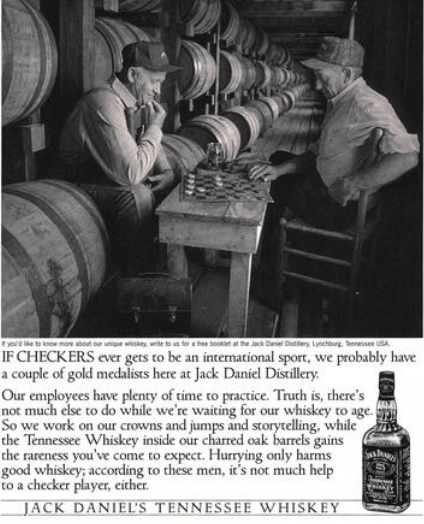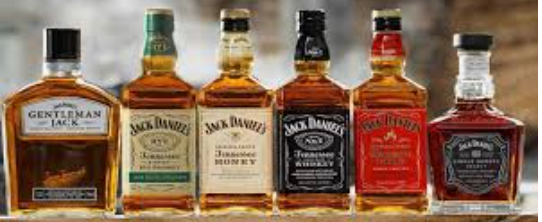Arthur S. "Art" Hancock
“The Man of Unforgettable Ads”
Two years before being purchased by spirits giant Brown-Forman, the Jack Daniel’s company, then an independent producer of Tennessee whiskey, decided to start advertising intentionally. Up until that point in its existence, the company had built a respectable business only by word-of-mouth marketing and by the unsolicited endorsement of celebrities, such as William Faulkner, Jackie Gleason, and, most famously, Frank Sinatra.
Enter Arthur S. “Art” Hancock, a recent advertising journalism graduate of the University of Iowa, who had just relocated his young family to Nashville. Taking advice from Jack Daniel’s great-nephew, Hap Motlow, who told the out-of-work ad man, “Go to Lynchburg. They’ll learn ya’ how to hang around.” The Lynchburg lessons took, helping Art to perfect his natural gift for “The art of talking with, rather than at people,” as Art himself later described it. Soon, the smooth-talking 27-year-old Hancock was the Jack Daniel’s company’s first marketing director.
For his first project, Hancock wrote a one-page marketing strategy. It was to be based on the authenticity of a distilling process unaltered since Jack Daniel conceived it just after the Civil War, and would be focused on the people who were the current generation of workers at the company’s distillery in Lynchburg: laid-back, casual, unaffected by the cares of the world, perhaps even a little lazy. One ad conceived by Hancock and approved by Jack Daniels management asked, “How many people work at Jack Daniels?” The answer: “About half of them.”
About as far from Madison Avenue as one could get, Art’s advertising/marketing plan was a radical departure from other whiskey ads at the time. Almost all other liquor brands’ advertisements in those days showed a tuxedoed man with a gorgeous woman in diamonds and pearls, holding a crystal-clad drink in luxurious surroundings. Along comes Art Hancock with his carefree men in dirty overalls and a catchy southern saying, clinging to not a single drink, but usually a whole, half-empty bottle of Jack.
Up until he retired in 1991, Art oversaw what has been hailed as America’s longest-running ad campaign. Jack Daniel’s iconic, homespun, black-and-white “postcards” did more than sell whiskey. They celebrated relationships and inspired new ones. The central strategy of Hancock’s ads hasn’t changed in nearly four decades since. The stories are continually refreshed, but the tone and message have remained constant from the beginning, with one important exception—Jack Daniel’s is now the best-selling American whisky in the world.
Another of Art’s brilliant and enduring advertising campaigns was born when, after running across a sepia photo of a town band outfitted by Mr. Daniel, Art convinced the company to revive and fund “Mr. Jack Daniel’s Original Silver Cornet Band”. The current members of the band have revitalized the original band that was started back in 1892 by Jack Daniel himself, who formed it in order to draw crowds to the town square in Lynchburg and thus his two saloons, The White Rabbit and The Red Dog. Daniel had gathered 13 "musicians," who were really just random townspeople from Lynchburg, to “play” in the square, and despite their lack of experience, the band was a hit. It was even invited to join in Democratic Party frontrunner William Jennings Bryan's presidential campaign and Tennessee gubernatorial candidate Robert Love Taylor's campaign. However, the band ended up disbanding in 1914 when nearly all the men of Lynchburg volunteered for service during World War I. In 1976, Hancock re-established “Jack Daniel’s Silver Cornet Band,” now chock-full of professional musicians from all over the country, which has enjoyed enormous success, having toured internationally for decades, recorded multiple albums, and starred in national TV specials.
Arthur Stewart Hancock was born in 1926 in Peoria, Illinois, to Canadian immigrants Clarence W. and Edith Stewart Hancock. At 12, Art went down the Mississippi River to New Orleans as a riverboat deckhand. At Peoria High School, Art caught the eye of Charlotte Sutton, and in 1951, “Char” became the beloved Mrs. Hancock. Ever since, Art said that every success he ever experienced was owed to Char’s belief in him. During World War II, Art served aboard the U.S.S. Boxer as a Navy airplane mechanic. Once safely back in civilian life, he used the recently instituted GI Bill to attend the University of Iowa.
Arthur Hancock passed away on January 23, 2023, at the age of 96. Art and Char had raised four children: Susan, Julie, Steve, and Art Jr., and they doted on their thirteen grandkids and three great-grandkids.
Art’s work made people around the world feel real connections with that tiny place nestled in the hills and hollows of Tennessee. The man considered the 20th Century’s “Father of Advertising,” David Ogilvy, once wrote of Art: “The more I see of liquor advertising, the more I admire his. If there is a better campaign in the industry, I have never seen it. Indeed, I would rank it among the half-dozen best campaigns in the history of advertising.”
Contributed by Tracy McLemore, Fairview, Tennessee
Current iteration of Mr. Jack’s ‘Silver Cornet Band’






